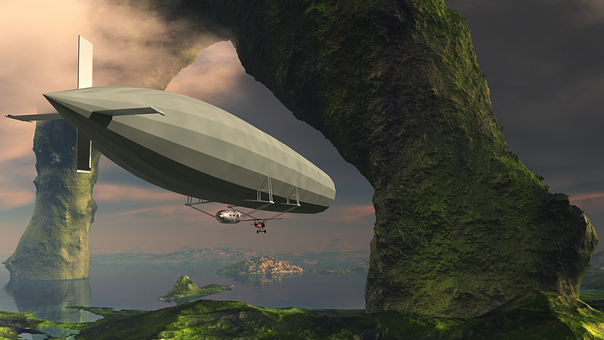 If you've ever read Jules Verne, you know his imagination took off in the direction of this topic along with other wonderful creations. In addition, most of us have seen the Hindenburg as it burst into flames in 1937 because its earned a place in history but if you read my entry a couple days ago, you know this was it's 63rd flight. This means that air travel using airships had been around for quite a while.
If you've ever read Jules Verne, you know his imagination took off in the direction of this topic along with other wonderful creations. In addition, most of us have seen the Hindenburg as it burst into flames in 1937 because its earned a place in history but if you read my entry a couple days ago, you know this was it's 63rd flight. This means that air travel using airships had been around for quite a while.Lets start with a bit of history. The flight of the first hot air balloon inspired a French engineer to design an 84 foot long dirigible powered by three engines back in 1783 but it was never built. Unfortunately, the designer and his American friend flew a hot air balloon over the English Channel, but had difficulty in keeping it high enough off the water and ended up throwing everything they could, including their clothing.
Other engineers played with the design, improving on it until in 1895, Count Zepplin created the Zepplin Airship. This one differed from earlier designs because the 110 foot vessel had a thin, rigid, tough skinned balloon filled with helium. In addition, it had a small crew and some passenger compartments suspended below the balloon. With its two 15 horsepower motors, it could reach speeds of 25 mph. At first they were used to take passengers on scenic trips operating as an airline but with the outbreak of World War I, the military ordered 20 Zepplins to make bombing runs over Britain.
Shortly after World War I, in 1925, Goodyear released its first Pilgrim airship which was capable of carrying two passengers, a pilot, and a mechanic. Its 80 horsepower engines gave it speed and it acquired a reputation for offering luxury cruises but later on, the United States government used them for surveillance but today, we see the Goodyear blimp at major sporting events.
In the mean time the Graf Zepplins acquired a reputation for its sleek lines cutting effortlessly through the air. By 1929, the Zepplin circumnavigated the world in 21 days while offering luxury unheard of in today's world. One year later, they created the Hindenburg class of airship, launching the first one in 1936 with public restrooms, promenades, cabins, restaurant, bar, and a smoking room. The interior designer covered the walls in hand painted silk showing scenes historic voyages. The cabins were only 78 inches by 66 inches with a set of bunk beds, and a sink. This airship rivaled the ocean going vessels of the time and the Hindenburg earned the nickname "hotel in the sky." because it could carry 50 passengers at a time.
Furthermore, the Hindenburg had an improved design so it could carry passengers ,cars, mail, cargo, and luggage across the Atlantic. It had four 16 horsepower diesel engines built by Daimler-Benz, the same company who engines for torpedo boats. Its skin had been impregnated with aluminum oxide to prevent UV radiation from passing through and it made the skin sparkle.
From 1936 to 1937, the Hindenburg made regular trips from Germany to America and back taking only 43 hours to complete one way instead of the normal 5 day trip. Other countries such as the United Kingdom tried to complete but they were not successful. After the fatal accident, airships as airlines didn't do well and World War II began. By the end of World War II, Zepplin, the company, went out of business.
By the end of World War II, various airlines had begun moving passengers across the ocean faster and in decent comfort replacing airships as the favored mode of transportation. At this point, airships were a thing of the past, only appearing here and there.
I hope you found this topic as interesting as I did. Have a great day and let me know what you think, I'd love to hear.
No comments:
Post a Comment